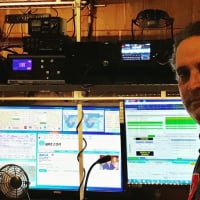Welcome to the FlexRadio Community! Please review the new Community Rules and other important new Community information on the Message Board.
Need the latest SmartSDR or 4O3A Genius Product Software?
SmartSDR v3.9.19 and the SmartSDR v3.9.19 Release Notes
SmartSDR v2.12.1 and the SmartSDR v2.12.1 Release Notes
The latest 4O3A Genius Product Software and Firmware
SmartSDR v3.9.19 and the SmartSDR v3.9.19 Release Notes
SmartSDR v2.12.1 and the SmartSDR v2.12.1 Release Notes
The latest 4O3A Genius Product Software and Firmware
If you are having a problem, please refer to the product documentation or check the Help Center for known solutions.
Need technical support from FlexRadio? It's as simple as Creating a HelpDesk ticket.
Need technical support from FlexRadio? It's as simple as Creating a HelpDesk ticket.
Remote Antenna Disconnect
Options

Mike-VA3MW
Administrator, FlexRadio Employee, Community Manager, Super Elmer, Moderator admin
This is so cool!
I really have to do this. Thanks from K4FWJ for posting this video.
Mike va3mw
https://player.vimeo.com/video/133917999
A single lightning strike can destroy thousands of dollars worth of radio equipment. Experienced amateur radio operators know the only sure protection is complete disconnection. This can be a chore, especially when multiple antennas are involved. As well, it is all-to-easy to forget to do it. This system makes it possible to accomplish hands-off multiple antenna disconnects and re-connects either on-site or remotely. It also provides for antenna rotator connect/disconnect. The on-site mode can be wired to automatically connect antennas when the radio equipment is turned on and disconnect them when the radio is turned off. The remote mode requires a web IP switch which is controlled by a PC or smartphone. The result is excellent lightning protection at any time from any place.
I really have to do this. Thanks from K4FWJ for posting this video.
Mike va3mw
https://player.vimeo.com/video/133917999
A single lightning strike can destroy thousands of dollars worth of radio equipment. Experienced amateur radio operators know the only sure protection is complete disconnection. This can be a chore, especially when multiple antennas are involved. As well, it is all-to-easy to forget to do it. This system makes it possible to accomplish hands-off multiple antenna disconnects and re-connects either on-site or remotely. It also provides for antenna rotator connect/disconnect. The on-site mode can be wired to automatically connect antennas when the radio equipment is turned on and disconnect them when the radio is turned off. The remote mode requires a web IP switch which is controlled by a PC or smartphone. The result is excellent lightning protection at any time from any place.
0
Comments
-
I like the idea as well. Below is a link to a thread in which we were discussing this same video a week ago along with station automation.
https://community.flexradio.com/flexradio/topics/using-amazon-alexa-to-start-stop-your-station
1 -
I use three of these devices, one per antenna feedline. When the radio gets powered on, so do the relays inside each of these lightning isolators:
https://paradanradio.com/products/antenna-disconnect
2 -
Hi Rick
Those work. The relays in those boxes have a very small space, maybe 2mm and lightning can easily jump across.
Some of us are looking for a bit more distance between the contacts on a total lightning disconnect in case of a closer strike.
For a remote operator, this is as close as you can come to tossing the coax back out the window!
Mike
1 -
If anyone is able/interested in doing it I will be interested in buying.
Santiago
HI8SMX0 -
That is correct. One of the only steps missing for making my shack better and safer and distance friendly.0
-
This is, as they say, "Brilliant!" But what kind of a ground (shield) connection is that (quick disconnects, similar to this, do not work well on F connectors)? But how can we thread those SO-239s with those PL-259s?
0 -
The UHF connectors are a push-on type typically used for bench work.
Many connector types have similar push-on versions available (pretty certain F, N, UHF, SMA and a few more).
I think with N-connectors the usual ****-together is not a true shield electrical connection.
73
Steve
K9ZW
Blog: http://k9zw.wordpress.com0 -
I am building one of these, my own design but it is probably not going to be available until spring of next year. The machine shop is just too busy.
This is a link to my cad model movie:
https://www.dropbox.com/s/59izoi2c95eg8kd/Mark%27s%20Lightning%20Assy.mp4?dl=0
The moving part is a grounding bar. The purpose of this bar is to short out static build up. It will not prevent lightening damage.
So the grounding side goes to your radios. The other side (right side) is antennas. The concept is that when you disconnect (pulling to the motor) the grounding bar (which perhaps has a steelwool like surface ground the center conductor of the connectors.
This as I said, is intended to keep static buildup from getting to your radio and popping those Flex ESD diodes.
I do plan to make this design available to people who desire it. Either they can buy an assembled unit, the metal plates and assemble it themselves or the plans and machine it themselves.
I do plan to have a D/C disconnect on the bar as well it is not shown in this early model.1 -
You can put me in with one assembled (I´m no good in making stuff myself).0
-
Following0
-
@Mark WS7M - what operating temperatures are your providing for? (Without adding heat or cooling figuring -40c to +50c would capture my QTH's extremes.)
What distance are you thinking to displace things by?
73
Steve
K9ZW
Blog: http://k9zw.wordpress.com0 -
I had a lightning strike this summer in the backyard. The only damaged was two gallium fuses in my lightning arrestors shorted to ground protecting my system. I don't turn the power off on any of my gear, that way the differential voltage remains stable.1
-
The distance right now is like 4 inches but that dimension is not yet final.
The connectors are going to be "shock mounted" which is the ME's way of saying there will be some give to help with alignment.
But I am open to temperature range recommendations.
For me personally it will always be in a dry place between 40F and 90F as it will be in an HVAC room which probably stays closer to 65 all the time.
I think to fit your -40C to +50C would be tough for almost any mechanical assembly with mating parts. For something requiring that we might have to use more stable materials (added expense) and maybe thicker surfaces. I'll ask the ME to be sure.1 -
Please check this video. This is my implementation of the same concept.
https://youtu.be/6BkzOGnGM7U
73
Manoj VU2CPL1
Leave a Comment
Categories
- All Categories
- 328 Community Topics
- 2.1K New Ideas
- 594 The Flea Market
- 7.8K Software
- 6.2K SmartSDR for Windows
- 168 SmartSDR for Maestro and M models
- 397 SmartSDR for Mac
- 260 SmartSDR for iOS
- 247 SmartSDR CAT
- 179 DAX
- 369 SmartSDR API
- 9.1K Radios and Accessories
- 15 Aurora
- 162 FLEX-8000 Signature Series
- 7.1K FLEX-6000 Signature Series
- 909 Maestro
- 51 FlexControl
- 854 FLEX Series (Legacy) Radios
- 873 Genius Products
- 446 Power Genius XL Amplifier
- 312 Tuner Genius XL
- 115 Antenna Genius
- 278 Shack Infrastructure
- 196 Networking
- 439 Remote Operation (SmartLink)
- 135 Contesting
- 726 Peripherals & Station Integration
- 136 Amateur Radio Interests
- 945 Third-Party Software



